Revista Boliviana de Química
versión On-line ISSN 0250-5460
Rev. Bol. Quim v.29 n.1 La Paz 2012
ARTÍCULO ORIGINAL
THEORETICAL MECHANISTIC VIEWS FOR SYNGAS, METHANOL, FISCHER-TROPSCH AND WACKER REACTIONS OF NATURAL GAS
José A Bravo,1 * J. Mauricio Peñarrieta,12 Juan Antonio Alvarado12
1 Instituto de Investigaciones en Productos Naturales (IIPN), Carrera de Ciencias Químicas, Universidad Mayor de San Andrés, Calle Andrés Bello y Calle 27 Cota Cota, Edificio FCPN, 2° piso, La Paz- Bolivia. 2 Instituto de Investigaciones Químicas (IIQ), Carrera de Ciencias Químicas, Universidad Mayor de San Andrés, Calle Andrés Bello y Calle 27 Cota Cota, Edificio FCPN, 2° piso, La Paz- Bolivia.
Keywords: Fischer-Tropsch, Wacker, Syngas, Methanol, Natural Gas, Mechanism
ABSTRACT
Theoretical mechanistic proposals for Syngas Reaction, Methanol Reaction, the Fischer Tropsch Reaction and the Wacker Reaction, used in the natural gas industry are here explained under the scope of the structural theory.
RESUMEN
Sobre las base de la teoría estructural, se proponen mecanismos de reacción teóricos para las reacciones de la industria del gas natural conocidas como Syngas, Síntesis de Metanol, Fischer Tropsch y la reacción de Wacker.
INTRODUCTION
The importance of proposals of mechanisms of organic reactions such as those employed in the natural gas petrochemical industry namely: Syngas Reaction, Methanol Reaction, the Fischer Tropsch Reaction and the Wacker Reaction is here remarked. Reaction mechanisms are firstly based on structural theory.1 Such first theoretical approach is fundamental and unavoidable for establishing ulterior kinetic mechanistic experimental protocols.2 The usefulness of such mechanisms can be appreciated when thinking about a possible application regarding any improving in the reaction's performance in the corresponding industry processes. This means that the petrochemical research should contemplate the establishment of such mechanisms. Currently we dispose of bibliographic data of mechanistic empirical-theoretical mechanistic approaches particularly for the FT process.3 4 5 6 Mechanisms also permit to define the reaction's limiting reagent on the basis of the molar relation for all reagents involved this under the scope of a petro-chemical derivatives production chain. The mechanistic views here proposed are supposed to employ the use of surface catalysts when applicable. These are not explicitly mentioned for simplifying reasons. All bond excisions are considered to be homolytic due to the high temperatures employed, the gas phase of the reaction medium and the sus of surface catalysts. These conditions drive us to the proposal of the existence of free radical intermediates in every partial reaction.
ANALYSIS AND MECHANISTIC PROPOSALS Syngas (Synthesis gas) and Methanol Synthesis
Syngas7 (Synthesis gas) is the name given to a gas mixture that contains varying amounts of carbon monoxide and hydrogen. Examples of production methods include steam reforming of natural gas or liquid hydrocarbons to produce hydrogen, the gasification of coal,8 biomass, and in some types of waste-to-energy gasification facilities. The name comes from their use as intermediates in creating synthetic natural gas (SNG)9 and for producing ammonia or methanol. Syngas is also used as an intermediate in producing synthetic petroleum for use as a fuel or lubricant via the Fischer-Tropsch process and previously the Mobil methanol to gasoline process. Syngas consists primarily of hydrogen, carbon monoxide, and very often some carbon dioxide, and has less than half the energy density of natural gas. The main reaction that produces syngas, steam reforming, is endothermic with 206 kJ/mol methane needed for conversion. Syngas is combustible and often used as a fuel of internal combustion engines10 or as an intermediate for the production of other chemicals. The three dehydrogening and oxygening reactions that permit the obtaining of carbon monoxide and hydrogen (syngas) out of methane that we consider the most common are:

First reaction.- Considered to be driven by radicals due to the high temperature. The use of copper, zinc oxide, or alumina corresponds to a surface catalyst and its application has not been explained in the following mechanism.

Mechanism:
1st step or first dehydrogenation-oxygenation: generation of methanol

2n step or second dehydrogenation: generation of formaldehyde

3th step or third dehydrogenation: generation of carbon monoxide

Second reaction.- Due to the high temperature applied, it's of the radical-type. The use of catalysts has not been graphically described, its action is understood.

Mechanism:
1st step or first dehydrogenation: generation of methanol and carbon monoxide
2nd step or second dehydrogenation: generation of formaldehyde
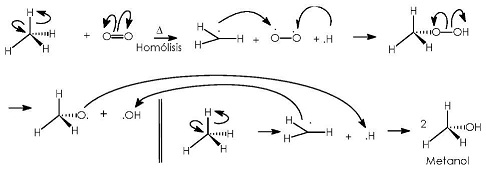
2nd step or second dehydrogenation: generation of formaldehyde


3th step or third dehydrogenation: generation of carbon monoxide

Third reaction.- Due to the high temperature applied, it's of the radical-type. The use of catalysts has not been graphically described, its action is understood.

Mechanism:
1st step or first dehydrogenation-oxygenation: generation of methanol


Methanol Synthesis from Methane
Carbon monoxide and hydrogen (or syngas obtained from methane) react on a second catalyst to produce methanol.11 Today, the most widely used catalyst is a mixture of copper, zinc oxide, and alumina first used by ICI in 1966. At 5-10 MPa (50-100 atm) and 250 °C, it can catalyze the production of methanol from carbon monoxide and hydrogen with high selectivity (>99.8%): copper, zinc oxide, and alumina where the H2O byproduct is recycled via the water-gas shift reaction

This gives an overall reaction, which is the same as listed above.

It is worth noting that the production of synthesis gas from methane produces three moles of hydrogen gas for every mole of carbon monoxide, while the methanol synthesis consumes only two moles of hydrogen gas per mole of carbon monoxide. One way of dealing with the excess hydrogen is to inject carbon dioxide into the methanol synthesis reactor, where it, too, reacts to form methanol according to the equation:

Some chemists believe that the certain catalysts synthesize methanol using CO2 as an intermediary, and consuming CO only indirectly.


The reaction - Due to the high temperature applied, it's of the radical-type. The use of catalysts has not been graphically described, its action is understood.
Mechanism:
3th step or third dehydrogenation: generation of carbon monoxide


The Fischer Tropsch Reaction
The Fischer-Tropsch process, or Fischer-Tropsch synthesis, is a collection of chemical reactions that converts a mixture of carbon monoxide and hydrogen into liquid hydrocarbons. The process, a key component of gas to liquids technology, produces a synthetic lubrication oil and synthetic fuel, typically from coal, natural gas, or biomass.12 13 The Fischer-Tropsch process has received intermittent attention as a source of low-sulfur diesel fuel and to address the supply or cost of petroleum-derived hydrocarbons.
The Fischer-Tropsch process involves a series of chemical reactions that produce a variety of hydrocarbons molecules according to the formula (CnH(2n+2)). The more useful reactions produce alkanes as follows:

where 'n' is a positive integer. The formation of methane (n = 1) is generally unwanted as methane is gaseous at standard temperature and pressure. Most of the alkanes produced tend to be straight-chain, suitable as diesel fuel. In addition to alkane formation, competing reactions give small amounts of alkenes, as well as alcohols and other oxygenated hydrocarbons14
The classical Fischer-Tropsch reaction is principally applied to synthesize hydrocarbons (linear alkanes C6 to C30 [diesel]). As an example we will propose the radical-driven-by mechanism for the synthesis of hexane from carbon monoxide and hydrogen. The FT synthesis presents the advantage of generating water as a secondary product. Water becomes nowadays a scarce vital element, thus this process contributes to ecology in such manner. The proposed mechanism understands the use of a surface catalyst (not shown).
The reaction.- Due to the high temperature applied and the use of catalysts, it's of the radical-type. The use of catalysts has not been graphically described, its action is understood. Example for n = 6 hexane

Mechanism:

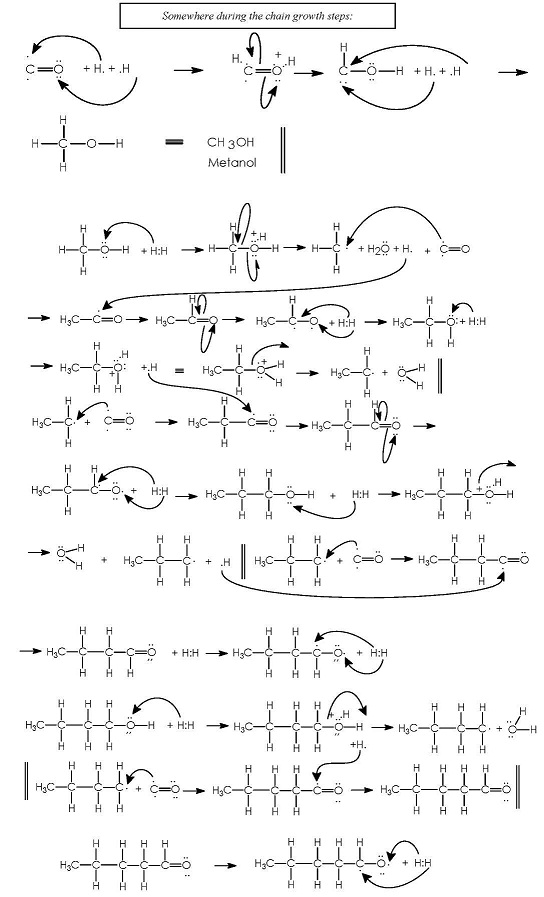
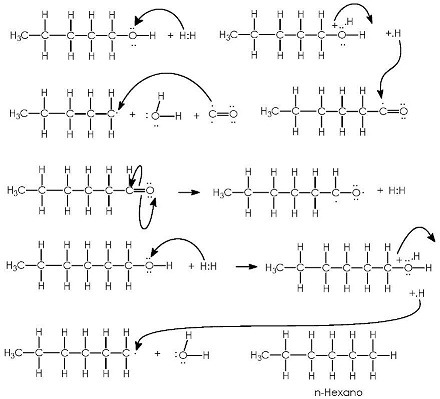
Our theoretical mechanistic proposal contemplates the carbon monoxide as the chain growth unit, contrasting with the methylene chain growth unit mentioned for some authors3
Chain termination steps
All reactions interrupting (chain terminating reactions) the propagating (chain growth reactions) are due to scavenging intermediate radicals, particularly those related to the C=O and H. radicals. These are the reagents whose control or managing could give orientation to the reaction toward the production of diverse other derivatives other than diesel. Let us mention that the number of new C-C bonds to be synthesized, it means the alkane's longitude, depends on the quantity of CO and H2 employed.
The Wacker Reaction15
An important industrial process based on the complex alkene-Pd is the Wacker Reaction. This is a catalytic process for the conversion of ethylene to acetaldehyde. The first step is the addition of water to the Pd-activated alkene. The addition intermediate suffers the characteristic elimination of Pd (0) and H+ to generate the couple enol-acetaldehyde.
The reaction - The reaction runs with only a catalytic quantity of Pd. The co-reagents CuCl2 and O2 serve to re-oxidize Pd (0) to Pd(II). The net reaction consumes only alkene and oxygen.

Mechanism:
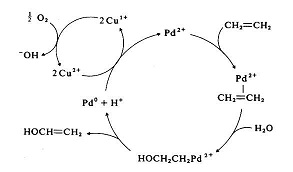
This redox cycle1 can be explained through the following eighteen partial reactions.
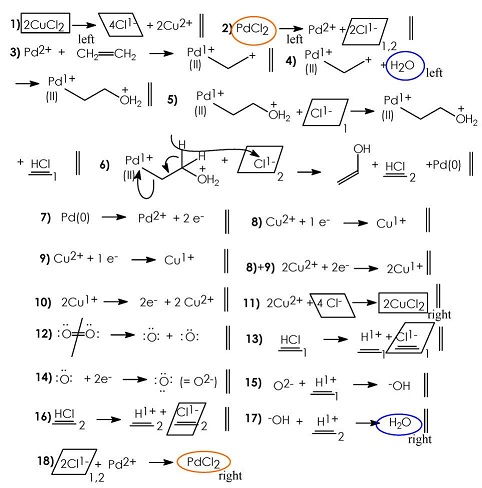
Finally the equilibrium enol-aldehyde gives the expected product or the acetaldehyde.

Notas
*Corresponding author: ioseabravo2004@yahoo.com.mx
1 Carey F. A., Sundberg R. J. Advanced Organic Chemistry. 3rd Edition, Part B: Reactions and Synthesis pp. 416-417, Plenum Press, 1990, New York.
REFERENCES
1 Bravo, J. A. The Organic Chemistry Notebook Series, a Didactical Approach,® (i) A theoretical mechanistic approach to diasteroselective synthesis of cis-1,2-dialkenylcyclopropanols and subsequent oxy-cope rearrangement by Jin Kun Cha et al. Bol. J. of Chem., 2005, 23, 1-10. (free download from http://www.bolivianchemistryiournal.or) [ Links ]
2 Gould, E. S.Mechanism and Structure in Organic Chemistry Holt, Rinehart and Winston, New York, 1960 [ Links ]
3 Nowicki, L., Ledakowicz, S., Bukur, D. Hydrocarbon selectivity model for the slurry phase Fischer-Tropsch synthesis on precipitated iron catalysts Chemical Engineering Science 56, 2001, 1175-1180 [ Links ]
4 Masuku, M. C., Hildebrandt, D., Glasser, D. The role of vapour-liquid equilibrium in Fischer-Tropsch product distribution Chemical Engineering Science 66, 2011, 6254-6263 [ Links ]
5 Ndlovu. S. B., Phala, N. S., Hearshaw-Timme, M., Beagly P., Moss, J. R., Claeys M., van Steen E. Some evidence refuting the alkenyl mechanism for chain growth in iron-based Fischer-Tropsch synthesis Catalysis Today 71 (2002) 343-349 [ Links ]
6 Carter, M.K. A molecular mechanism for Fischer-Tropsch catalysis Journal of Molecular Catalysis A: Chemical 172 (2001) 193-206 [ Links ]
7 Syngas http://en.wikipedia.org/wiki/Syngas, accessed 28.04.12 [ Links ]
8 Beychok, M. R.Coal gasification and the Phenosolvan process, American Chemical Society 168th National Meeting, Atlantic City, September 1974 [ Links ]
9 Beychok, M.R. Process and environmental technology for producing SNG and liquid fuels, U.S. EPA report, EPA-660/2-75-011, May 1975 [ Links ]
10 Syngas in Gas Engines www.clarke-energy.com, accessed 15.11.11 [ Links ]
11 Production of methanol from synthesis gas http://en.wikipedia.org/wiki/Methanol#Production_of_Methanol_from_synthesis_gas, accessed 28.04.12 [ Links ]
12 The Fischer-Tropsch reaction http://en.wikipedia.org/wiki/Fischer%E2%80%93Tropsch_process#cite_note-0, accessed 28.04.12 [ Links ]
13 The Fischer-Tropsch reaction http://tonto.eia.doe.gov/dnav/pet/pet_cons_psup_dc_nus_mbbl_m.htm, accessed 28.04.12 [ Links ]
14 Kaneko T., Derbyshire F., Makino E., Gray D., Tamura M. "Coal Liquefaction" in Ullmann's Encyclopedia of Industrial Chemistry, 2001, Wiley-VCH, Weinheim. [ Links ]












 uBio
uBio 

